 |
| An artist's impression of the Rhynie Chert, the oldest terrestrial ecosystem on the planet |
Whatever the case, it was thought that the invasion of the land was a fairly recent event. Yet earlier this year, a team of palaeontologists led by geologist Gregory J. Retallack, from the University of Oregon, uncovered from 2.2 billion year old Precambrian cliffs, composed of compacted prehistoric soils known as palaeosols, at the Hekpoort Formation near Waterval Onder, South Africa, a series of small fossils far more complex than anything else from that time in the Earth's history.
Demonstrating that they were fossils was a technical triumph because they were too big to be seen in a standard microscopic slide. The samples were imaged using powerful X-rays from a cyclotron, a particle accelerator, at the Lawrence Berkeley National Laboratory in California. The images enabled a three-dimensional restoration of the fossils' form. Named Diskagma buttonii, which means 'disk shaped fragment of Andy Button,' they are about the size of a match head and similar in shape to an urn with a tubular, hollow body enclosed at one end and open at the other, with a small stem at the base.
 |
| A reconstruction of the 2.2 billion year old fossils of Diskagma buttonii with a scale bar |
but something rather more simple,' said Retallack, professor of geological sciences and co-director of palaeontological collections at the University of Oregon's Museum of Natural and Cultural History.
'There is independent evidence for cyanobacteria, but not fungi, of the same geological age, and these new fossils set a new and earlier benchmark for the greening of the land,' he said. 'This (gives) added significance because fossil soils hosting the fossils have long been taken as evidence for a marked rise in the amount of oxygen in the atmosphere at about 2.4 billion to 2.2 billion years ago, widely called the Great Oxidation Event.'
It is likely that the rise in oxygen was the trigger which resulted in these creatures or possibly their ancestors making the move onto dry land. Exactly what the structures represent is mysterious. Retallack has proposed that they might represent relatives of Geosiphon based on their morphology. Even so, it is difficult to identify what they truly are. If Retallack is right, then they are eukaryotes, the proper name given to complex organisms. This, however, presents a problem in light of a recent genetic study conducted by researchers from the University of California, Berkeley.
 |
| Is it possible that these fossils represent the oldest eukaryotes on the planet? |
One possibility is that eukaryotes evolved twice. This, however, is highly unlikely. The other is that the genetic evidence is wrong, again unlikely. Time and time again, genetics has revealed the truth. By contrast, the fossil record is imperfect. Yet I reiterate: these fossils are too complex to ignore. Simple cells, or prokaryotes to give them their proper name, cannot create such structures by themselves. Only eukaryotes, or a combination of prokaryotes and eukaryotes can do this. For now, we shall have to wait on new evidence before we can truly say what these fossils are and what they tell us about the origin of complex cells.